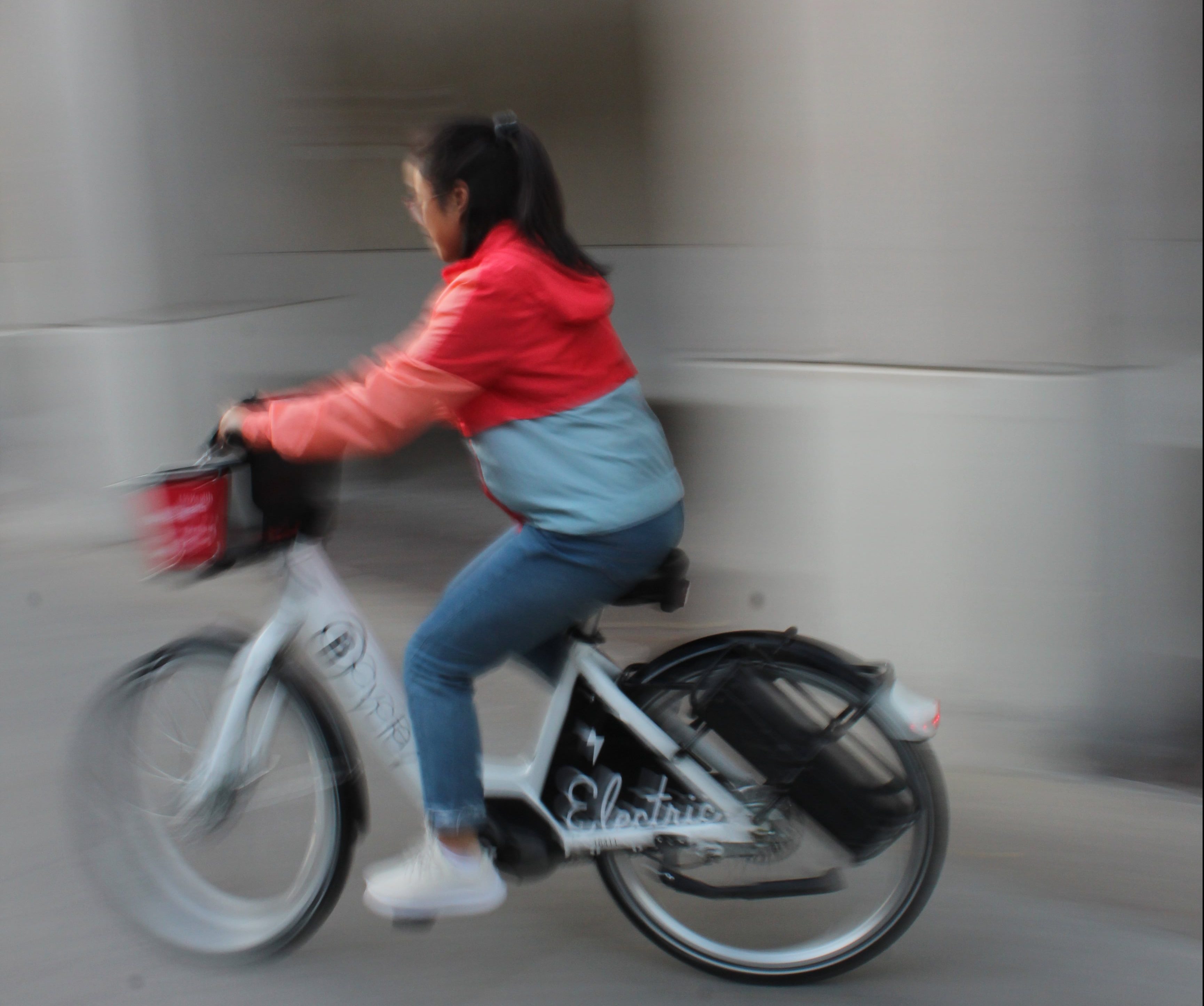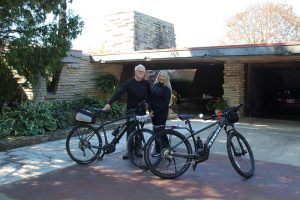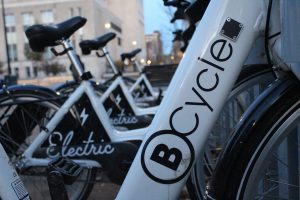Bike with a Boost

BIKE WITH A BOOST
E-bikes electrify Madison's transit scene
Kathleen Bartzen Culver was looking for pain management, a way to relieve the inflammation she felt in her joints after two hip replacements. What she found was an electric bike, which she purchased on Memorial Day in 2018 and has since pedaled for more than a thousand miles.
“I was reading on some pain management blogs that this is something a lot of people have benefitted from and that keeping your joints in motion without bearing a lot of weight was really important,” Culver says.
After her initial research, Culver tested several e-bikes over the next few weeks, eventually purchasing a 2018 model from the brand Specialized. While she originally planned to use it for recreation, Culver quickly realized she could use it to commute to her job as the James E. Burgess Chair in Journalism Ethics at UW-Madison. The round-trip journey to campus from her home in Fitchburg, Wisconsin, a suburb south of Madison, is 17 miles, and she can bike it in less time than it would take to drive and park.
E-bikes have quickly become a popular option in the biking world, with e-bike models and choices available for fitness, recreation, commuting and even racing. Public bike sharing systems have also joined the trend, and Madison became the first city in the U.S. to completely convert its bike sharing system to e-bikes this past summer. As individuals look to buy or rent bikes, riders are choosing e-bikes over their motorless counterparts because of their versatility and ease of use. E-bikes are also a popular choice for those with aging joints, or people who want to ride longer distances and keep up with a stronger riding partner.
Consumers might also consider an e-bike to reduce their carbon emissions footprint. Eric Bjorling, a spokesman for Trek Bicycles, says e-bikes are the first thing that’s ever been able to truly replace a car.
“In the United States, 40 percent of all car trips are under two miles,” Bjorling says. “And an electric bike takes care of a lot of the reasons people haven’t been able to approach cycling as a transportation option as often as they may like.”
Most major bike manufacturers now produce and sell their own e-bike fleets, ranging in price from a little less than a thousand dollars to several thousand dollars. Some are designed for fast riding on pavement, some for mountainous terrain, and others for commuting or recreation. E-bikes also sped into the professional racing world this past summer, as the first ever E-Mountain Bike World Championships were held in Mont-Sainte-Anne in Quebec, Canada.
E-bikes work like regular bikes but with an integrated electric motor, usually located by the pedals or on the back wheel. The motor batteries can be charged from a wall outlet and have a range of between 50 and 80 miles. Because the batteries are often the most expensive part of the bike, they lock onto the frame and can only be removed with a key. Riders use a set of buttons located on the handlebars to use the motor and tell it how much help — or assist — they want.
Despite how quickly some enthusiasts have adopted them, others remain skeptical, asking, “Is it really even a bike?” or dubbing them “cheater bikes.” Culver is well aware of these apprehensions.
“The way I describe it is that it’s like biking with someone’s hand on your back,” Culver says. “It’s just that little bit propelling you forward a little bit faster, but if you don’t put in effort, you don’t go.”
To anyone who has never ridden an e-bike before, the first few pedals with the assist on can be a little jarring, similar to hitting the accelerator a little too hard on a touchy car. After a few strokes, however, your cadence smooths out, and it feels extremely similar to a normal bike — just easier and faster.
Joyce and Phil Wall live in Mount Horeb, Wisconsin, 20 miles west of Madison, and each bought an e-bike last spring. Joyce, who is in her 60s, had been riding her regular bike nearly 20 miles a day for fitness, but was having a hard time keeping up with Phil and didn’t want her rides to be strenuous.
“Due to my age, I just didn’t want to do that anymore, so we tried e-bikes, and I loved it immediately — it just has a little more support and help,” Joyce says.
Phil bought his own e-bike within weeks of her.
“I bought her an e-bike so that she could keep up with me, and after I bought her a bike, I couldn’t keep up with her, so I bought one.”

Joyce and Phil Wall are constantly outracing each other on their new e-bikes. (Photo by Justine Spore)
Phil says e-bikes have changed the way they go around the hilly town of Mount Horeb, too.
“We’ve always taken a level route to stay high so that we don’t have to go back up the hill. Now we go everywhere in town and have seen all kinds of things that we never knew existed,” he says. “We go through the back alleys and straight up the hill, it doesn’t matter.”
Besides fitness and commuter transportation, e-bikes have made their way to bike sharing, as Madison’s BCycle replaced its regular fleet with 300 e-bikes in June. The project was made possible by a partnership with bike manufacturer Trek, which is based northeast of Madison in Waterloo, Wisconsin. BCycle has docking stations across the city from which e-bikes can be rented and returned.
In a recent interview with the Badger Herald, executive director of Madison BCycle Lisa Snyder said the switch has encouraged community members who normally wouldn’t rent a bike to give it a try.
“We have overwhelming feedback that people love the electric bikes, and we are seeing it with 2.4 times the ridership,” Snyder told the Badger Herald. “We’ve had 75,000 trips in two months since June 18. In comparison, we had 31,000 trips the same two months in 2018 with the [non-motorized] bikes.”
Snyder also said 37 percent of riders reported using their cars less often because of BCycle.
David Noyce, executive associate dean of the College of Engineering at UW-Madison, is an expert on transportation safety, traffic and bikes. He says bike sharing systems offer a lot of benefits for cities that implement them, including added mobility to existing transportation systems.
“What some other cities are finding is that cities have natural hubs, and allowing another form of transportation … allows people to move in a more ad hoc way such that people aren’t getting in cars and buses aren’t overcrowded,” Noyce says.
As an e-bike owner himself, Noyce traveled to a Chicago suburb to buy a specific brand of e-bike for his wife and himself.
“They’re just so easy. I mean, you can crank it down so you really have to pedal … and then flip on the [assist] if you really wanted to climb,” Noyce says.
E-bikes have allowed people to continue exercising and biking in a less strenuous way but could pose traffic problems. As more individuals take to the streets and trails with e-bikes, Culver says she worries about collisions at higher speeds.
“I’m really glad that people like me have that door opened to them, but as more people go through that door it’s going to present some problems, some crowding and speed problems,” Culver says.

Madison BCycle docking stations across the city allow anyone to take the new electrified fleet for a spin.
Noyce says that legally, all bicycles and e-bikes are technically vehicles, along with cars and scooters. His own e-bike, along with most other e-bikes, have a governor built in that limits maximum speed to between 17 and 25 miles per hour. Noyce says that unless the next generation of e-bikes has the ability to go roadway speed, he doesn’t anticipate seeing any additional restrictions for e-bikes on bike paths or multi-use trails.
“Even if you really crank it … you’re still not going even slow vehicle speed,” he says. “And what the law says is that bikes need to yield to pedestrians and that the pedestrian has the right of way on the bike path or shared use path,” Noyce says.
Despite potential issues, Madison is uniquely situated to host a growing e-bike market and sharing system, with more than 50 bike trails covering 505 miles, according to the Rails-to-Trails Conservancy. In October, UW-Madison was also named a platinum-level Bicycle Friendly University, one of only eight such institutions in the U.S.
Culver says living near a great trail system is one reason she is able to commute by e-bike and feel safe doing so.
“I tell other people in Madison, ‘Go get an e-bike,’ but if I were to live in Rio, Wisconsin, I wouldn’t feel comfortable on country roads or that sort of thing,” she says. “I think lots of places are working on ways to improve the bike experience because what a great state to do it in — so gorgeous.”
The Walls shared a similar sentiment, saying that part of the reason they ride and enjoy their e-bikes so much is because they live just blocks away from Military Ridge State Trail and can access traffic-free routes easily.
Even though e-bike commuting has posed new challenges for her, Culver says her daily rides have had a positive impact on her in more ways than one, reducing her pain and also allowing for more fresh air in her daily life.
“The biggest surprise benefit that I hadn’t realized is that with the work that I do … I really have not been outside that much,” Culver says. “So when I got the bike, I was just outside for an hour to an hour and a half every day, and that had tremendous benefits to it. I just really felt better because I was connecting with nature and getting fresh air.”
She has also encouraged others to invest in their own e-bikes.
“This friend of mine was like, ‘Why are you so happy?’ and I was like, ‘I got this e-bike, it’s wonderful!’ and she went out and bought one,” Culver says.
For Bjorling, e-bikes are more than a car alternative or strength equalizer — they’re just plain fun.
“I have never seen a product where 100 percent of people come back after testing it with a gigantic smile,” Bjorling says. “I left things intentionally at the store once, just so I could take another trip back.”
Take an e-bike ride around Madison

Justine Spore | Copy Editor
Senior studying both strategic communications and environmental studies
